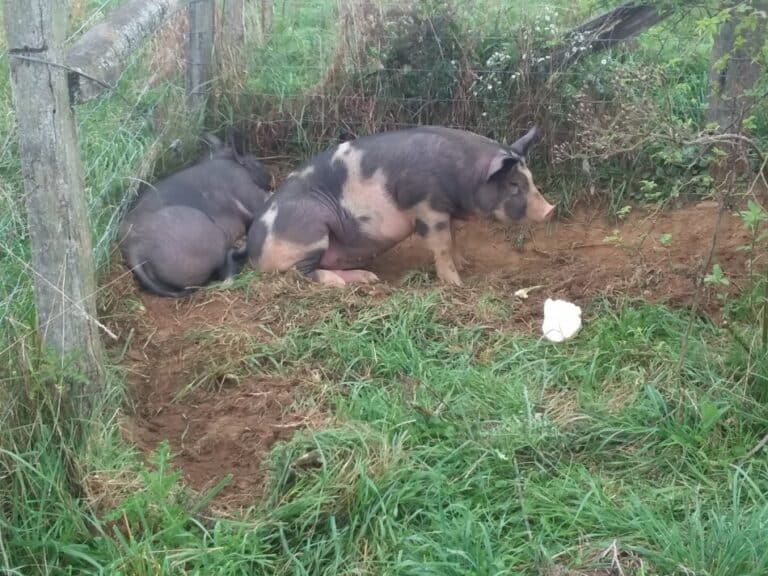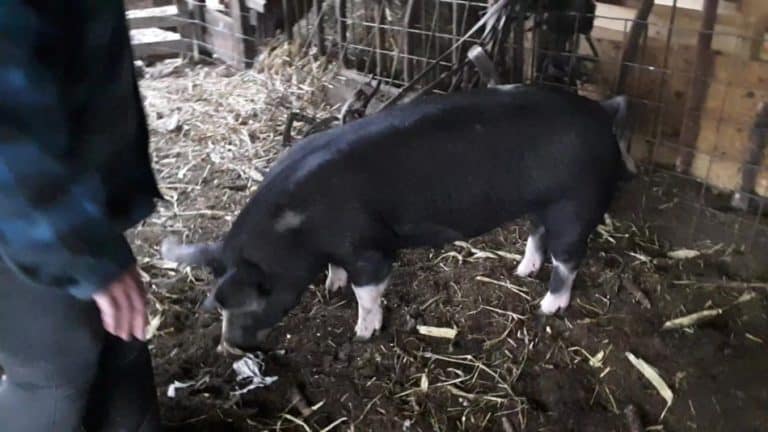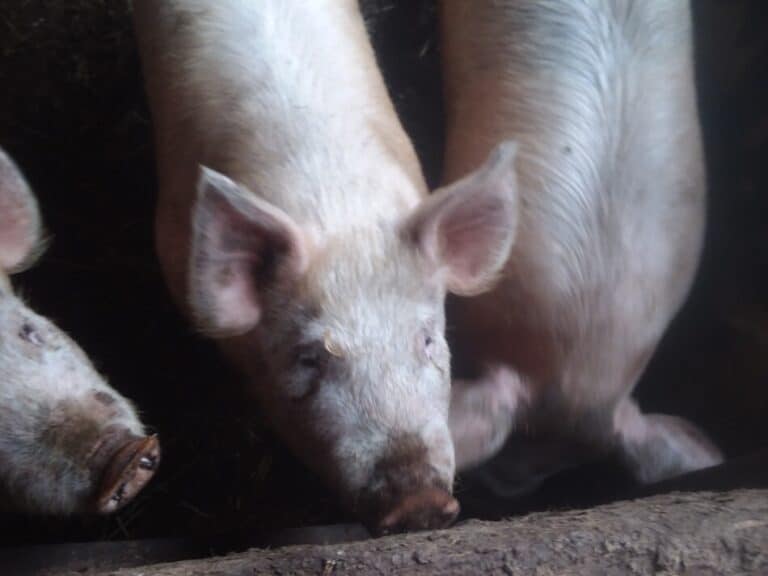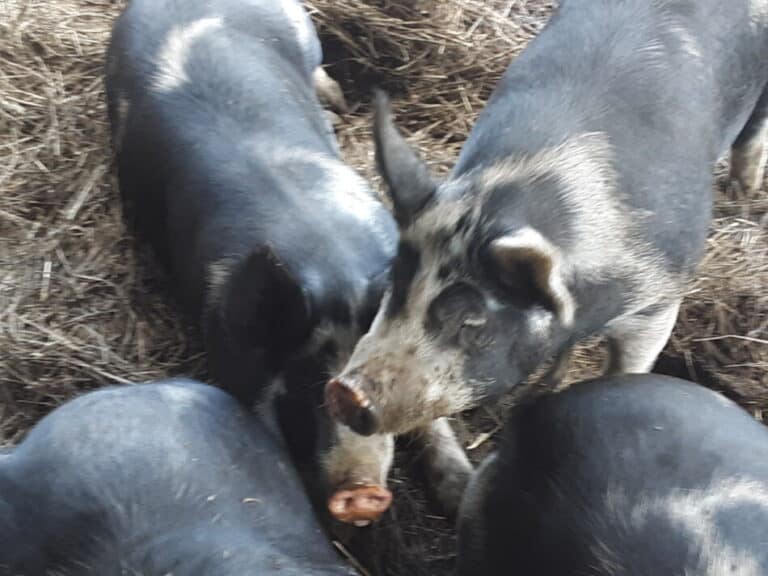Can You Make Money Raising Pigs?
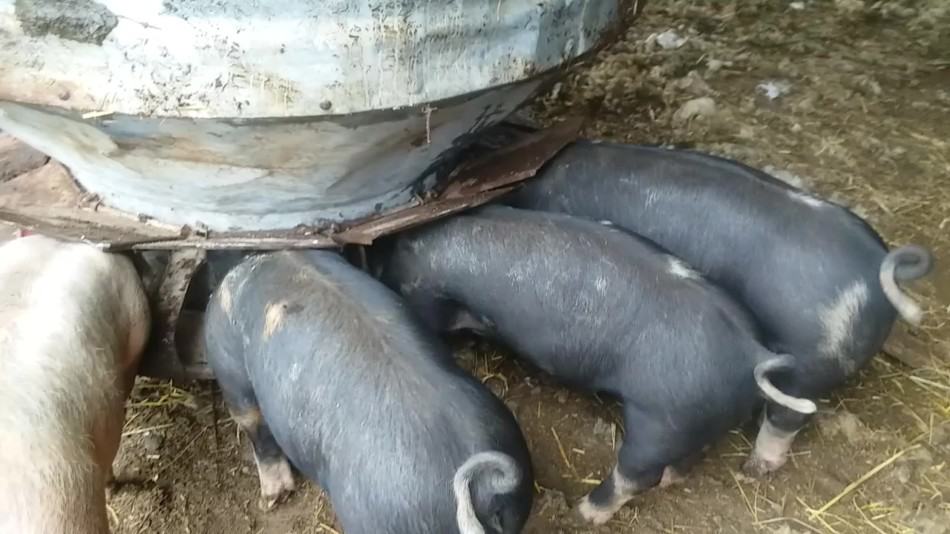
Thinking about raising some pigs to sell? Before getting started, you need to have a plan.
You can make money raising pigs, as long as feed costs are kept low and you are selling the type of pig your market wants.
Starting a new business is exciting! I know it can be easy to get a great idea and jump right in.
But before you do, let’s look into the practical aspects of raising and selling pigs.
You’ll need to: estimate how much money you will be able to make selling pigs and figure out who’s going to buy them!
Is Raising Pigs For Meat Worth It? shows you a budget for raising your pigs for your freezer.
4 things to know before you get pigs
- Where is the closest custom slaughterhouse?
- Where is the closest livestock auction?
- Where are you getting the feed?
- Where are you getting the pigs?
These questions are the basic considerations you need to think about before you get going with your pig operation.
When you look into the logistics of raising and selling pigs, consider what you are willing to do and what are the deal breakers for you.
You’ll notice I listed these in backwards order, (slaughtering first, buying pigs last) that’s done on purpose.
You need to have a place to sell your pigs before your get them!
Find the closest custom slaughterhouse
“Custom” slaughterhouse, not just slaughterhouse, is an important distinction.
The big industrial slaughterhouses do not work with individuals or small producers.
You’re looking for a butcher whose business is working with small producers and the customers of that producer.
Most custom butchering businesses have a listing online, many have a website. (An exception here would be businesses run by members of the plain community.)
We are fortunate to live in an area that has quite a few options for custom slaughter.
If that is not the case for you, how far are you willing to drive, or pay for a trucker to drive your pigs, to the slaughterhouse?
Don’t forget you, or your customers will have to go there and pick up the meat as well.
Pros And Cons Of Raising Pigs goes over the good and the not so good of raising pigs.
Find the closest livestock auction
Check out your local livestock auction. Do you even have a local auction? Is is a busy place or is it dying?
Look over the market reports and see how feeder pigs or market hogs are selling in your area, be sure to look over the whole year. (Sometimes demand is seasonal.)
Do those prices look good to you? If so, run the numbers and see if you are happy with how your pig raising venture would be paying.
If not, figure out a different way to sell your pigs or raise something else.
We sell our pigs at the local auction. In our area, the local livestock auctions run every week, (there are four within an hour of our farm).
Here are a few of the reasons selling at the auction works around here:
- Most of the pigs produced in the U.S. are under contract for the large agribusiness companies, anyone wanting a few market hogs can’t get them from the big farms. An option to get pigs, if the person doesn’t raise their own is going to the auction to get what they need.
- Small butcher shops would need to buy a few pigs a week for in house sales. For example they would need to stock pork cuts, like pork chops and roasts. Additionally, they want to have plenty of pork available for grinding with other meats, like hot dogs, that are normally a mix of beef and pork, and with the sausage part of a deer processing order.
- We also have a large Amish population in the area that normally buy a market hog or two in the fall to slaughter for winter meat. With a lot of Amish families in the area, and a large amount of them wanting to slaughter their own meat, yet not raising a few pigs, fat hogs tend to sell well at auction.
If you are looking to make the most money per pig, you will need to sell the pigs to individual customers, instead of selling through an auction.
However, the final plus of an auction is that I always get paid, with customers sometimes getting paid can be difficult.
Here is the Market Report page for our local auction. Pick a date and look over the prices. Your area will probably have something similar, if not, find the report that is closest to you.
Find a reliable source for pig feed
You’ll need to have a reliable feed source for your pigs.
Most people would be looking at buying bagged feed from the farm store or the feed mill, (see the next section for the details on price).
However, since pigs are incredibly versatile in what they can eat, you may have other options.
Look around your area. What food resources are available but not being used?
Pigs can eat all sorts of food waste, like commercial kitchen scraps and produce that isn’t quite customer quality.
These are just two ideas of many. See what you can find.
Pig Feed: what you can and can’t feed pigs is an article from Western Australia Agriculture and Food going more into the specifics of commercial pig feeding. Your area will have information like this, as well.
Keep in mind that you could also use part purchased feed and part sourced food for your pigs, it doesn’t have to be 100% one way or the other.
For us, grinding our own feed is the best option. For you? You’ll have to do some digging and run the numbers.
Get pigs from a farm
Getting the pigs themselves is the next thing to consider. Are you thinking of buying feeder pigs or raising your own from a few sows?
An auction is the best place to start your search. I’m not saying buy anything there yet (you’re not ready), I’m saying get an idea of the current prices.
Look through the market reports for an idea of seasonality and demand.
No local auction? Consider online listings or use the ever popular method, just start asking around.
Note: the harder it is to get your pigs the more they are likely to cost.
Around here a nice feeder pig will cost between $35-75 each, depending upon the time of year.
The price for your area completely depends upon supply and demand.
An example: a small farmer about a half hour from here has a few litters of a specific breed of pigs available to purchase throughout the year, advertised online.
The pigs are sold as feeder pigs for about double the going price.
Are those special piglets worth the extra money? Apparently so, since they sell out every time! Will this work for you? Maybe, maybe not.
Know your costs to raise pigs
This is the big determiner of success for your pig operation. You must be able to raise pigs for a reasonable amount of money.
Next you have to sell them for a decent profit, we’ll get into that in the next section. For now, let’s look into costs.
Feed-the biggest cost you’ll have
The feed expenses to raise a pig to market weight are going to be more than the cost to buy the pig to begin with!
It’s worth a look around your area to scout out a good supplier of feed for your pig operation. Preferably, one that grinds the feed on site.
Why? First off, it’s fresh. Secondly, it’s much cheaper per pound. And third, you can get a custom mix if you need it.
Most mills will have a minimum batch weight, but be sure to ask.
Feed from feed mills is much cheaper per pound than the 50 pound bags of feed at the farm store. How much cheaper? Right around half price!
It’s worth calling around to try and save yourself $100 or so per pig! Click here for my article that goes into the details on feed costs.
At most, get enough feed to last for 2.5-3 weeks. Most mills keep a certain amount of bulk bagged feed ready to be picked up.
Call a day or so ahead to make sure they can set aside what you need or know to make another batch and reserve some of that for you.
If you need to pick up feed after work, you can
Can’t make it to the mill during business hours? They will set out your order for you to pick up if you ask.
Two things to consider before you make the call:
- you’ll be loading your feed order yourself
- should someone mistakenly grab your order instead of their own, you still pay for the feed.
If picking up feed after hours doesn’t work for you consider asking about a delivery.
The place we order from runs a bagged feed delivery route every other week.
Buying pigs will have seasonal price changes
Of course, you can raise your own feeder pigs, should you choose.
Most people would be buying a few batches of feeder pigs first, before getting into raising the pigs for themselves, so that’s where we’ll start.
When To Buy A Feeder Pig is an article I wrote to help you decide what’s right for you and your farm, if you want to check into it.

Feeder pigs have a seasonal demand. Everyone wants pigs in the spring and not a lot of people want them in the fall.
This is for two reasons, the easy one is the weather-it’s easier to feed and water a group of pigs in the non frozen months.
Especially, if you are planning on raising the pigs in the woods or pasture.
The second reason for pigs being more popular in the spring is the show pig season, specifically market hog prospects for the county fairs.
When I go to the Kidron Auction, the best place to buy feeder pigs in this area (and maybe the whole region), the place is packed in the spring.
The last few times I’ve gone, in October, it was practically a ghost town in there.
The time of year is a huge consideration for feeder pig price and availability.
Reality check on pig and feed expenses
One final consideration regarding buying feeder pigs: it is very unlikely that you will make money on your pigs if you buy them as feeder pigs in the spring, feed them the farm store bagged feed (the more expensive per pound feed) and sell them as market hogs at the auction.
Here’s the math for my area using a $60 feeder pig and 600 pounds of feed at $0.36/pound:
$60 feeder pig + $216 feed costs=$276 total costs
Bulk bagged feed price of $0.16/per pound (ground at the local feed mill)
$60 feeder pig + $96 feed costs=$156 total costs
If you are selling a 250 pound market hog for $0.50/pound you are getting $125 each before fees and commissions are taken out.
Of course, none of these numbers would include your time, utilities, improvements, etc.
This chart uses the costs above ($156 and $276) to raise a pig and shows you a few examples of the prices you would get at auction and the profit or loss of raising the pig.
| Feeder Pig + Feed Cost | Selling Price | Profit Or Loss Per Pig |
| $276 | $125 ($.50/#) | loss of $154/pig |
| $156 | $125 ($.50/#) | loss of $31/pig |
| $276 | $175 ($.70/#) | loss of $101/pig |
| $156 | $175 ($.70/#) | profit of $19/pig |
| $276 | $250 ($1/#) | loss of $17/pig |
| $156 | $250 ($1/#) | profit of $94/pig |
I must tell you that I have yet to see the price go up to $1/pound for a market hog, so don’t count on that, unless the market reports for your area show you it’s likely.
The highest I have seen is $0.70/pound and that is on 280-300 pound pigs.
Locals like these really fat pigs to grind in with deer meat, it’s a popular in the late fall/early winter around here.
Raising your own feeder pigs
If you are planning on raising your own feeder pigs, you should be able to drop the cost of the feeder pig down to around $25-30 each.
Of course this depends on your costs to get them to feeder pig size, but it would make selling them more economical.
Click here for my article that goes into detail about all of the costs and pros and cons of raising your own feeder pigs.
Area to raise your pigs
One of the biggest pluses regarding pigs is how adaptable they are, you don’t need a special building for your pigs to be happy.
That being said there are some facility needs to consider before you jump into pigs.
Pigs need some sort of shelter. Even if they are on pasture, they still need a place to get out of the sun and wind.
Pigs will excavate out the floor of the pen if they can. Especially if the floor is dirt. Wet dirt will definitely be rooted through and rearranged by the pork patrol.
This isn’t a big deal, if you can move them over to a new spot. If you need to keep them in the same spot, reset the post and strengthen the pen.
Fix potential problem spots before they get out! Once they escape, they will redouble their efforts to get out, since they now know it is possible.
Selling options for your pigs
- Livestock auction
- Direct to customers as 1/4, 1/2 or whole hogs
- Retail cuts
Selling your pigs through the livestock auction
We’ve just started raising pigs again. We had pigs around 10 years ago or so but stopped raising them when the market price plummeted.
We sell our pigs at the auction, so that was a rough market for a few years for anyone selling hogs.
People who sell direct to customers cruised right on through just fine, anyone selling through the normal livestock markets got out of the pig business.
Now, there are not many independent pig raisers left and that opens up a good opportunity for the small producer.
Why? That’s easy, local slaughter houses still need pigs to put in the meat case.
People who don’t want to raise their own pigs but love the taste of homegrown pork put in orders at the auction for a market hog or two.
In our area, the Amish like to get a pig for fall butchering, especially the deer hunters. They grind the pork in with the deer for sausage.
Since the vast majority of pigs raised in the U.S. are under contract, you can’t buy their pigs at the farm.
There are not a lot of available market hogs for the person that doesn’t want to buy pork from a chain store’s meat cooler.
Not familiar with livestock auctions? My article How Do Livestock Auctions Work will be helpful to you, it’s written specifically for sellers.
Selling direct to customers
Selling pork directly to customers is the best way to keep more of the customer’s money in your business, while supporting your local butcher and providing superior quality pork to your foodshed.
Like anything else in life, to get more money from selling your pigs you need to be responsible for more and do more.
In order to keep more of the money from your pigs, you will need to put in more work, this time with marketing, making sales and arranging schedules.
Your pigs can be sold by the whole, half or quarter or in retail cuts. Each will have advantages and disadvantages.
The most noticeable being the size of your sale (whole, half, quarter vs. a few chops) and if you need to keep the meat in your freezer (retail cuts at a farm store).
In Ohio, we have some pretty strict rules about getting the pigs processed in an approved slaughterhouse in order to sell to customers.
As far as I am aware, the rest of the U.S. has the same restrictions regarding meat sales.
If you are planning on selling retail cuts, you will also need a farm label and to take your pigs to an approved slaughterhouse.
Be aware that not all slaughterhouses are able to label your meat so that it can be sold across state lines.
Please note: we rarely sell pigs privately, so this is just a basic overview. If you want more information on selling privately look into my resource page titled People You Should Know.
Any of these folks will have great information for you. These are all people I look to for ideas and enjoy reading their thoughts and watching their videos.


